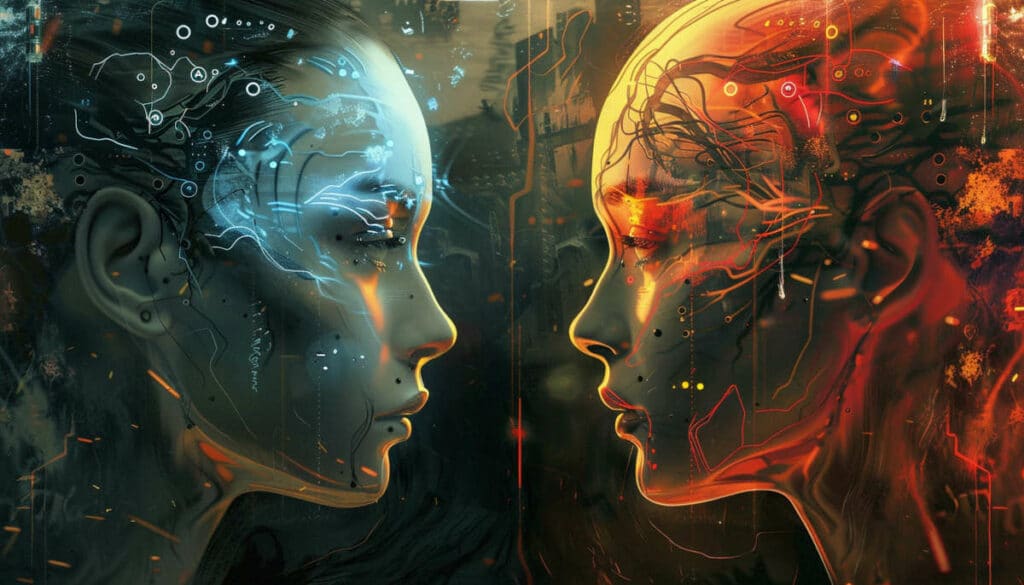ChatGPT, Midjourney, Sora... The feats of artificial intelligence continue to astound us. Yet, are we discussing strong AI or weak AI here? What sets these two types of artificial intelligence approach apart in simulating human intellect?
At the start of the movie Terminator 2, a scene that has profoundly impacted many unfolds. Emerging from another world, the robot portrayed by Schwarzenegger finds himself in a bar, completely nude, and begins to scan the humans around him, cataloging each one, before approaching a pool player to deliver the line: “I need your clothes, your boots, and your motorcycle.” The characters are unaware, unable to discern that this Terminator is unlike any human among them.
Debuted in 1991, this film advances the legacy of multiple precedents, ranging from Isaac Asimov’s 1940s robotics to the anxious butler depicted in Star Wars (1977), all showcasing artificial intelligence in motion.
Are such accomplishments within our grasp today? To unpack this, grasping the distinction between weak AI and strong AI is crucial.
The Aim of AI
As a refresher, artificial intelligence epitomizes the myriad attempts over more than five decades to enable machines to mimic human thought processes.
What is Weak AI?
Since the millennium’s turn, artificial intelligence has stealthily infiltrated various domains: healthcare, finance, voice recognition… When your bank flags a suspicious transaction, it’s actually an AI application raising the alarm.
A noteworthy example is the autonomous vehicle Waymo (previously acknowledged as Google Car). The passenger steps inside, requests a trip to Santa Barbara, and off Waymo goes, adjusting its operation to match the flow of traffic, dodging moving obstacles, especially those unpredictable pedestrians.
AI has subtly woven itself into our daily lives, whether through interactions with voice assistants like Siri or Alexa, or when Netflix suggests movies based on our preferences and the viewing habits of others with similar tastes.
Following the success of ChatGPT since late 2022, we’ve stepped into the dawn of readily available AIs. Numerous outlets have lauded the prowess of this application, capable of answering a wide array of inquiries, whether typed or dictated.

All these advancements surely qualify as strong, don’t they? Indeed, but… The AIs mentioned so far are categorized as weak AIs. Surprising, isn’t it? So, why label them “weak”?
A weak AI, or specialized AI, is designed for specific, narrowly defined tasks. Thus, Waymo, despite its impeccable autonomous functionality, is solely adept at navigating a vehicle with unparalleled precision but is restricted to just that. Moreover, it acts upon human commands, such as when tasked with driving to Santa Barbara.
In the same manner, ChatGPT qualifies as a weak AI, though it’s relatively sophisticated. This conversational AI is governed by a set of explicit algorithmic rules and is dependent on a learning model crafted from a vast textual corpus. It can guide us in preparing an herbal omelet but falls short of physical execution. In essence, ChatGPT merely responds to our inquiries and lacks any form of volition.
Similarly, Midjourney or Suno.ai generate artistic outputs based on predefined models and upon our requests. This also holds true for the AlphaGo system, which outmatched a world-leading Go champion, and other systems built for specific tasks.
What is Strong AI?
The entity personified by Schwarzenegger in Terminator 2 better aligns with our expectations of strong AI.
So, what exactly constitutes strong artificial intelligence? This term alludes to a theoretical AI model that demonstrates human-like intelligence and autonomous decision-making capabilities. This means a strong AI would amalgamate the functions of ChatGPT, Waymo, Siri’s voice recognition, AlphaGo, Netflix’s recommendation engine, and all other forms of weak AI. Furthermore, it would possess the capacity to self-educate, strategize a sequence of actions for any given problem, and execute those strategies.
Undoubtedly, such an AI would be realized in a humanoid robot format, enabling it to manipulate objects just as we do. A key consideration is that a strong AI would perform so adeptly that interactions with it would be indistinguishable from interactions with a human being. Noteworthy too is the potential for such AI to self-repair or even repair its counterparts.
As things stand, no strong AI exists, and predictions regarding the emergence of such a superintelligence vary widely, stretching from 2068 to 2138. This implies a significant journey still ahead.

Strong AI and AGI
How does General Artificial Intelligence (AGI), often intertwined with the idea of strong AI, fit into the picture? In reality, AGI represents a subset of strong AI. While their capabilities may mirror each other, strong AI enthusiasts argue that it might eventually cultivate self-awareness, a concept some still deem utopian or fanciful. John Searle, an American philosopher, encapsulated this in 1980 with “the Chinese Room argument”. He envisioned a scenario where someone who doesn’t speak Chinese is isolated in a room with various instruction manuals. Despite their lack of understanding, they manage to match messages in Chinese with predefined responses, creating the illusion of comprehension, albeit through strict rule adherence.
AGI seems more within reach, and from our perspective, it should embody the capabilities of strong AI minus that elusive essence machines may never quite capture.










